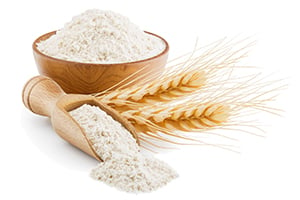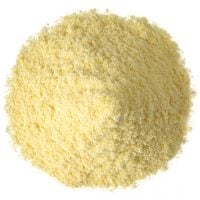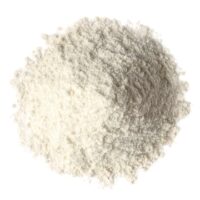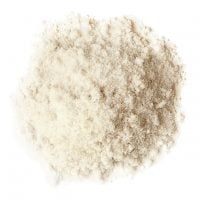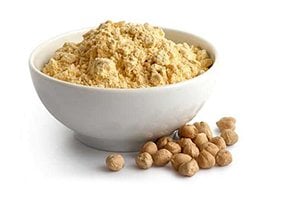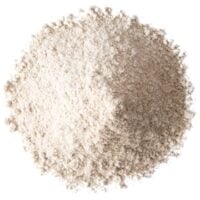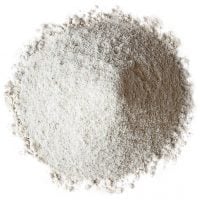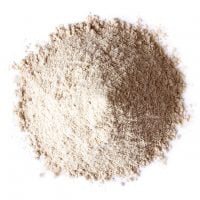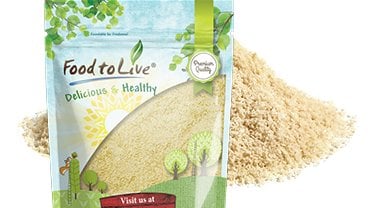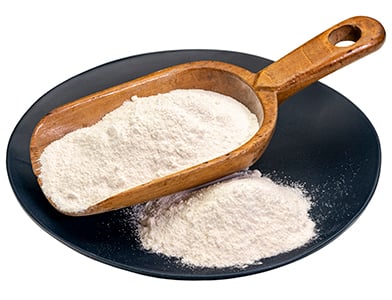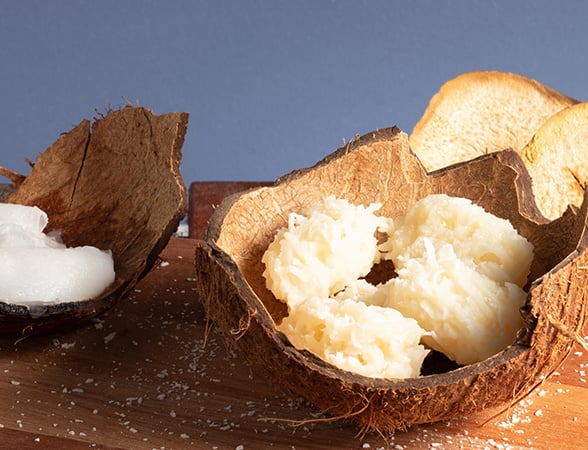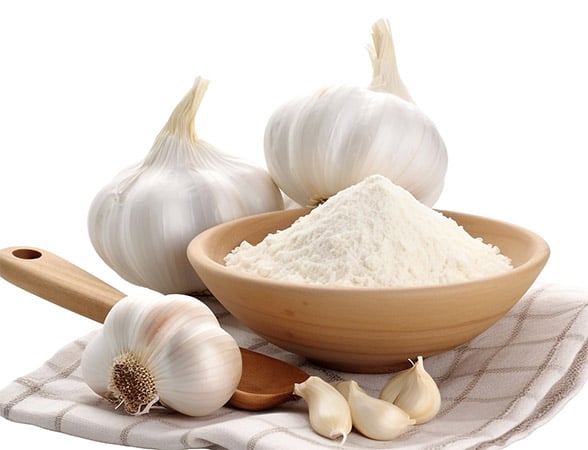August 28, 2021 · Written by Foodtolive Team
Flour Guide: Everything You Need To Know About Different Types of Flour
What tastes better than freshly baked bread? Even if you cut down on flour products because of some reasonable reflections, you still most likely consumed bread in your childhood. This article is to conduct a comprehensive “flour guide” so that you learn more about flour types for baking and flour types for bread. The key goal is to remind you how crucial this product is and what healthy recipes you can use it in.
WHAT IS FLOUR
Flour is defined as food produced by grinding grains of various agricultural crops, mainly cereals.
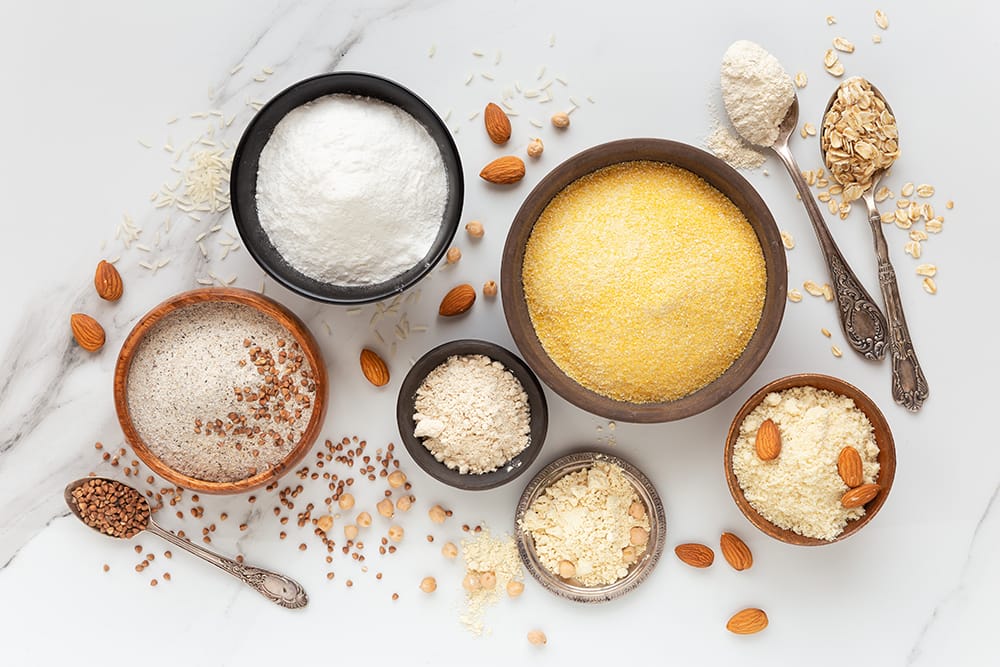
It is made from varieties of grain crops such as wheat, rye, buckwheat, oats, barley, millet, corn, and rice. Wheat and rye are the most popular types of baking flour. Still, if we compare these two, the usage of wheat prevails over rye type. Such tendency is explained by the pleasant taste and high nutritional value of wheat flour products as well as the specifics of the zoning of wheat and rye cultivation.
WHY IS IT IMPORTANT TO CHOOSE THE RIGHT FLOUR FOR YOUR BAKING
The key to the success of any dish is the selected ingredients. You should figure out which flour is best for baking pancakes, pies, or plain bread. It is necessary to take into account the type of flour, as well as the method of storage and its uses. There are a few basic criteria that you can focus on in the store:
- Take special attention at the storage place: the flour should be kept in a clean, dry, odorless store or room. There should be no meat or other food in the compartment.
- Make sure the expiration date is valid: no more than eight months. If the term is longer, it is likely to contain preservatives.
- Check the nutrition label.
- The flour should taste a bit sweet.
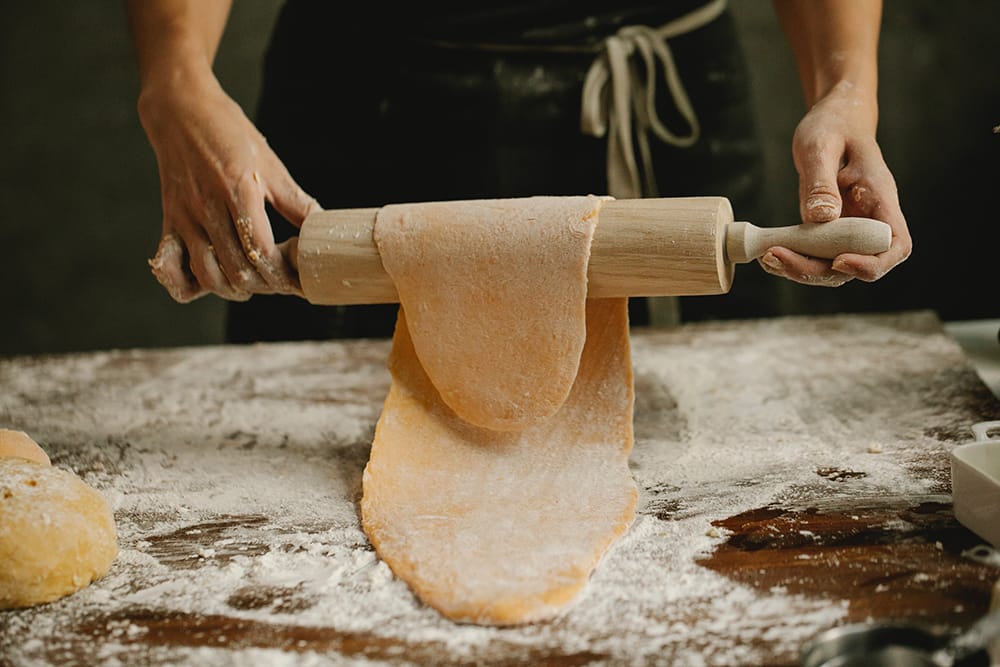
AMOUNT OF PROTEIN AND WHY IT MATTERS
Protein in flour matters because gluten is proportional to protein in wheat and in some other flours. Gluten has a positive effect on yeast breads and a negative effect on quick breads, cakes, and pastries.
Protein content can impact the functional properties of the flour and doughs/batters including water absorption, cohesiveness, dough strength, texture, loaf volume, and crumb grain. Using flour with more protein content could make your baked goods tougher or chewier than desired.
FLOUR TYPES AND THEIR CHARACTERISTICS
All-Purpose Flour
All-purpose flour is produced by grinding wheat kernels cleaned of bran and germs. This flour type is well known for its high content of iron and B vitamins: (thiamine, niacin, riboflavin, and folic acid).
- Perfect for: bakery products, cakes, cookies
- Not suitable for: No major restrictions
- Protein content (1 cup): 13 g
- Substitute for all-purpose flour: You can use all-purpose altogether with whole-grain flours to reduce the overall protein content in the recipe — for example, a half whole-wheat and half all-purpose mix to avoid dense muffins. Note that Gluten-free all-purpose flour blends can be substituted one-to-one since they work absolutely the same in the recipes.
- Recipe ideas: Garlic Herb Thanksgiving Dinner Rolls
Pastry Flour
Pastry flour is a low-protein flour ideal for baked goods. It has a high percentage of starch and less protein than other flours which allows you to get soft and delicate pastries.
- Perfect for: biscuits, scones, pie crusts, quick breads, donuts, cupcakes
- Not suitable for: No major restrictions
- Protein content (1 cup): 3 g
- Substitute for all-purpose flour: Pastry flour is suitable for all bakery goods. Being very soft, it goes well in the recipes where tenderness takes priority (cakes, muffins, quick breads). In this case, both all-purpose flour and pastry flour can be used interchangeably.
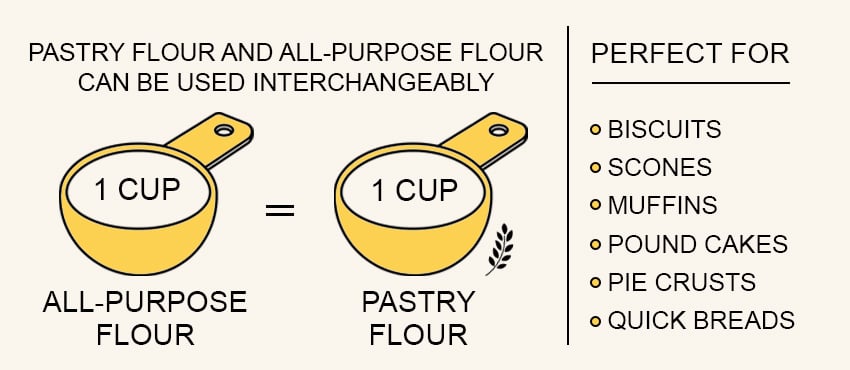
- Recipe ideas: Cinnamon Sugar Mini Pumpkin Donuts, Halloween Orange Velvet Ghost Cupcakes, Black Velvet Whoopie Pies
Whole Wheat Flour
Whole grain flour is made by grinding whole wheat grain (germs, bran, and endosperm). For this reason, whole wheat flour usually has more protein than regular flour.
- Perfect for: bread, pasta, muffins, pizza dough
- Not suitable for: Can contain sugar; not recommended for gluten intolerant people
- Protein content (1 cup): 16 g
- Substitute for all-purpose flour: In most cooking uses you may substitute whole wheat for all-purpose flour without issue. Start by swapping one-third of the amount of flour in your recipe for whole wheat (if your recipe calls for 1 cup flour, use ⅓ cup whole wheat and ⅔ cup all-purpose).
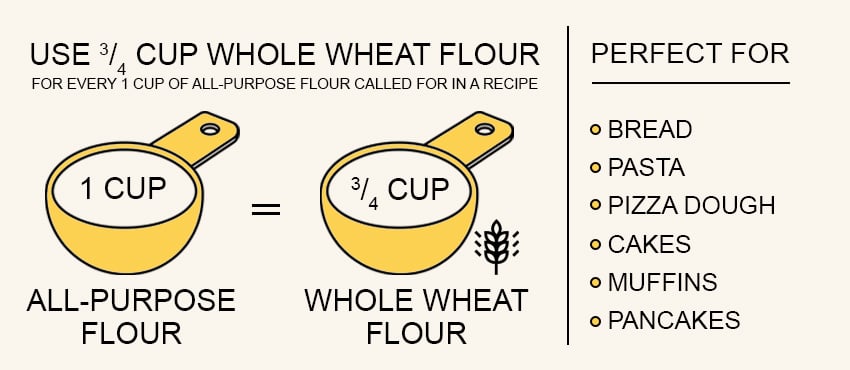
- Recipe ideas: Classic Raisin Bran Muffins with Whole Wheat Pastry Flour
Rye Flour
Rye flour is obtained by grinding rye grains. This flour contains less gluten than wheat flour. Therefore, it is easier to digest. Moreover, rye flour is rich in minerals (phosphorus, potassium, sodium, sulfur, calcium, magnesium, manganese, iron); vitamins (groups B: thiamine, pyridoxine, riboflavin, folic, nicotinic acid; E, or tocopherol; A); valuable amino acids (lysine, niacin, etc.)
- Perfect for: Bread, cakes, scones, pancakes
- Not suitable for: Not recommended for gluten intolerant people
- Substitute for all-purpose flour: To substitute by volume, start with this: 1 cup all-purpose flour is approximately equivalent to 1 cup + 2 tablespoons medium rye flour.
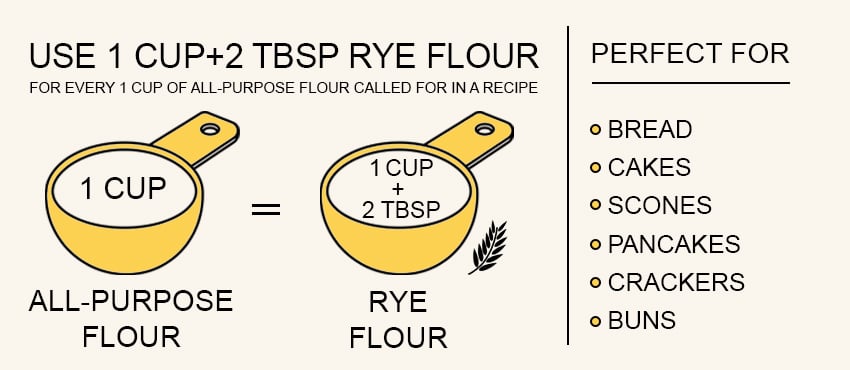
- Recipe ideas: Marrow Pancakes with Basil Chive Cream
Amaranth Flour
Amaranth flour is naturally gluten-free, high-protein flour. This flour is produced by grinding amaranth grains. Amaranth flour is rich in fatty acids and contains tocotrienol, which is a powerful form of vitamin E. There are about five times more iron and three times more fiber in amaranth flour than in wheat flour. It is also rich in other trace elements, including potassium, phosphorus, and vitamins A, C.
- Perfect for: Bread, pancakes, cookies cinnamon rolls, scones, muffins
- Not suitable for: No major restrictions
- Protein content (1 cup): 18 g
- Substitute for all-purpose flour: Amaranth flour is dense in texture, so it can be used on its own. Still, it can substitute all-purpose flour in baked goods by up to 25 percent.
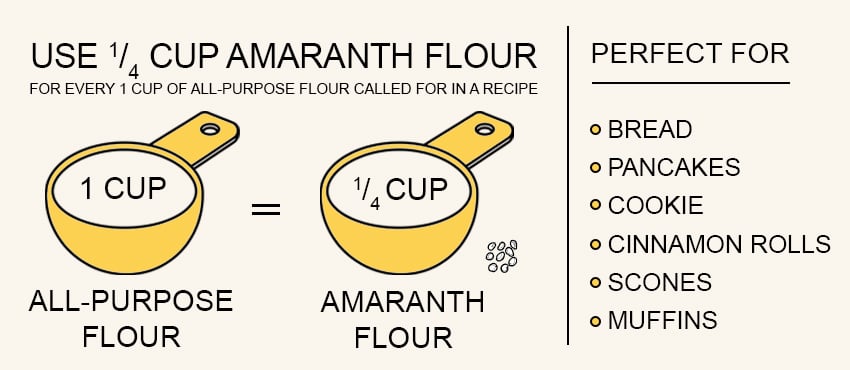
- Recipe ideas: Amaranth Sweet Potato Gnocchi
Barley Flour
Barley flour is grayish-white in color. It has no taste or smell, however, the dish baked with this flour tastes tart due to the high amount of fiber. Barley flour is one of the healthiest flours, as it is a good source of vitamins A, B, PP, as well as iron, potassium, sodium, and other trace elements.
- Perfect for: cookies waffles, muffins, pancakes
- Not suitable for: No major restrictions
- Protein content (1 cup): 16 g
- Substitute for all-purpose flour: You can replace 20-25% of all-purpose flour with barley flour without worrying about making other changes to the recipe.
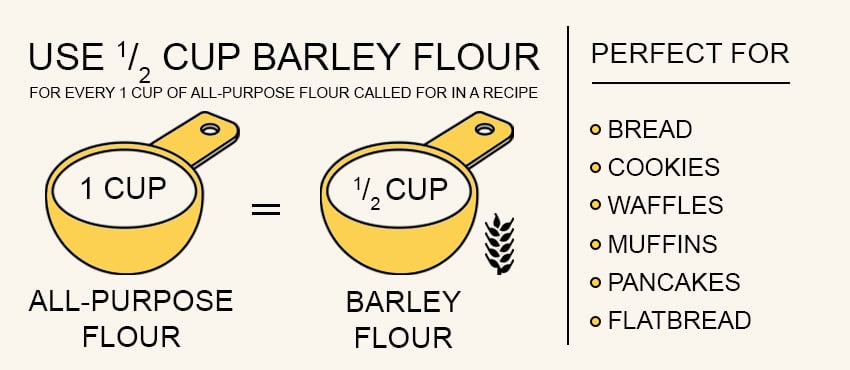
Buckwheat Flour
Buckwheat flour is produced by grinding buckwheat groats. It is absolutely gluten-free, so it’s a great alternative for gluten intolerant people. Moreover, Buckwheat flour is so nutritious that it regulates cholesterol levels, provides the body with fiber and plenty of lecithins. Note that Buckwheat flour is of two types: light (made from hulled buckwheat) or dark (unhulled). The light one is finer-textured and subtler in taste while the dark one has more fiber and flavor.
- Perfect for: Cookies, scones, biscuits, soba noodles, quick breads, crepes, pancakes, crackers
- Not suitable for: No major restrictions
- Protein content (1 cup): 15 g
- Substitute for all-purpose flour: You can generally swap 25 % of the all-purpose flour with buckwheat flour (by weight or volume). If you are not familiar with the assertive flavor of buckwheat flour, it’s better to start adding a mix of buckwheat and rice flours.
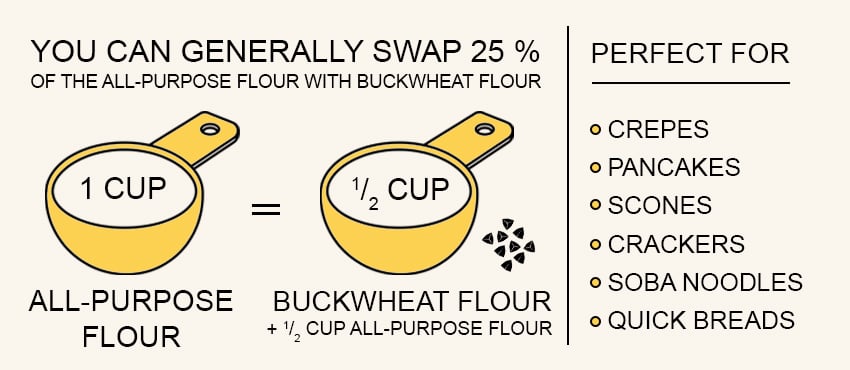
- Recipe ideas: Apple Gruyere Buckwheat Biscuits, Buckwheat Scones With Cherry Jam, Buckwheat & Oat Cutout Cookies
Cassava Flour
Cassava flour is a variety of flour without wheat made by heating and drying the fibrous root of cassava. Naturally, it is absolutely gluten-free, so cassava flour is beneficial both for gluten-intolerant people and for those who strive to keep a healthy diet.
- Perfect for: Bread, pies, crepes, tortillas, pizza crust
- Not suitable for: No major restrictions
- Protein content (1 cup): 3.9 g
- Substitute for all-purpose flour: While you can usually swap cassava flour for all-purpose flour using a 1:1 ratio, it is not perfect for every recipe. Cassava flour has a very similar consistency but it is lighter than all-purpose flour. This means baking with it can be tricky. Cassava flour is lighter, yet it absorbs more liquid.

- Recipe ideas: Cassava Flour Pizza Crust
Coconut Flour
Coconut flour is a soft flour produced from coconut that has been dried and ground. This flour has a mild, sweet, and fairly distinct taste. Coconut flour tends to absorb much more liquid than other flours. For this reason, it cannot be used as a one-to-one substitution. Note that coconut flour is absolutely safe to eat raw. Furthermore, it is a wonderful low-carb option for no-bake recipes.
- Perfect for: Cakes, cookies, muffins, pancakes, savory crepes
- Not suitable for: No major restrictions
- Protein content (1 cup): 20 g
- Substitute for all-purpose flour: You can’t substitute coconut flour on a 1:1 ratio for all-purpose flour, or most other flours, but try to cut down the amount of flour to ¼ of what you would normally use.
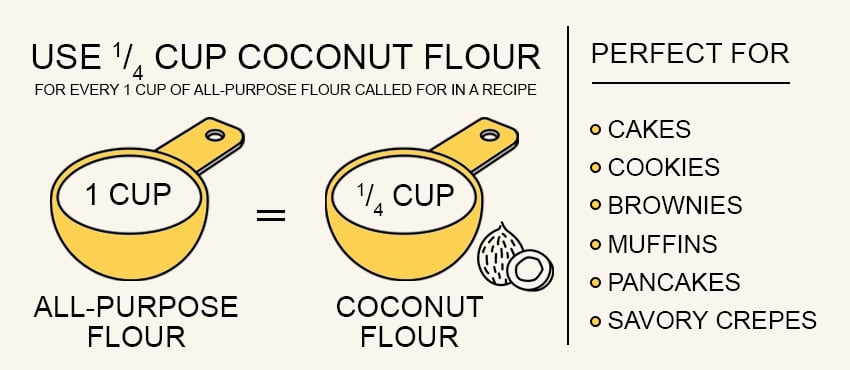
- Recipe ideas: Chocolate Vegan Mug Cake
Sponsored by Food to live
Corn Flour
Corn flour is made by grinding corn grains. Like corn, flour has a slightly sweet taste and is yellow in color. Corn flour is normally more dense and crumbly than other flours because it’s naturally gluten-free.
- Perfect for: bread, pancakes, waffles, pastries, tortillas, biscuits
- Not suitable for: No major restrictions
- Protein content (1 cup): 8.1 g
- Substitute for all-purpose flour: Corn flour can be easily replaced for all-purpose flour in baking. Use 1/4 cup corn flour for every 1 cup of all-purpose flour called for in a recipe.
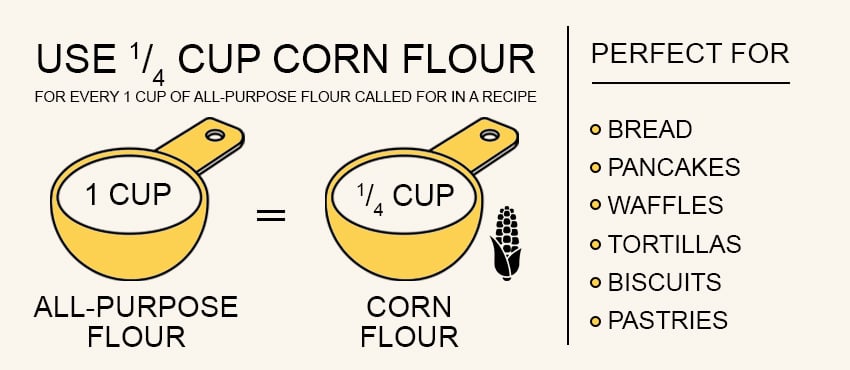
- Recipe ideas: Zucchini Cheddar Corn Waffles
Garbanzo Bean Flour
Garbanzo bean flour (also called chickpea flour) is a great gluten-free alternative to wheat flour. Chickpea flour is a pulse flour made from a type of ground chickpea called gram chickpea. It has a nutty taste and is rich in various nutrients: Protein (higher proportions than other flours), fat, fiber, folate, iron, carbs, phosphorus, thiamine.
- Perfect for: Bread, pizza, cakes, pizza crust, flatbread, frittatas, egg substitute
- Not suitable for: No major restrictions
- Protein content (1 cup): 20 g
- Substitute for all-purpose flour: You can substitute up to half the amount of all-purpose flour called for in a recipe with chickpea flour. This works best for quick breads and yeast breads. All-purpose flour doesn’t have the same complex, nutty taste as garbanzo bean flour, so the flavor of the finished dish may be significantly different.
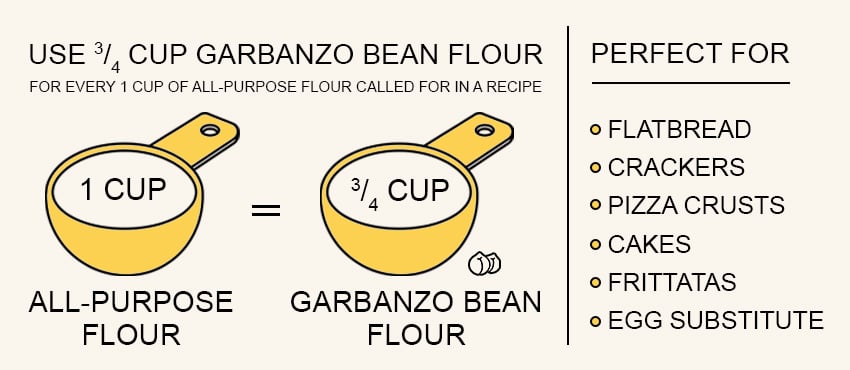
- Recipe ideas: Tuscan Chickpea Flatbread, Chickpea Flour Mini Vegan Frittata
Kamut Flour
Kamut grains are old relatives of durum wheat; the kernels are two or three times bigger in size than wheat grains. Kamut flour has an amber color, oily smell, and mild taste with a sweetish nutty flavor.
- Perfect for: Bread, biscuits, cakes
- Not suitable for: Contains gluten
- Protein content (1 cup): 15 g
- Substitute for all-purpose flour: Kamut flour is versatile. It can be used as a substitute for wheat flour for any meal you prepare.
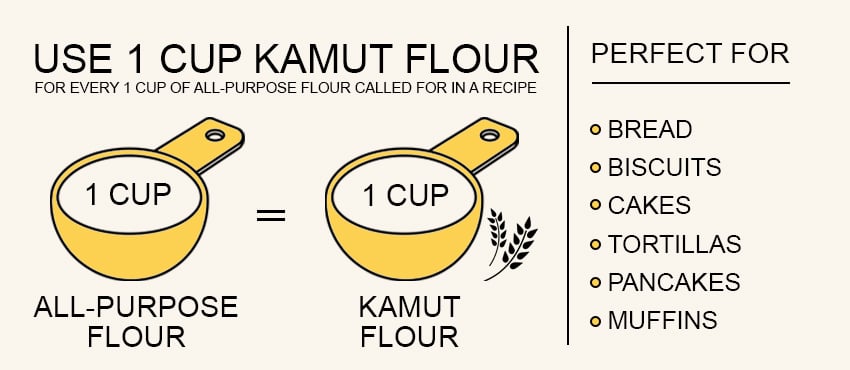
Millet Flour
Millet Flour is stone ground and whole grain with subtle flavor, lots of vitamins and minerals like protein, essential amino acids, and dietary fiber. Millet flour gives a light, sweet-nutty flavor and a crumbly texture to baked goods. And most importantly, it provides baked goods with useful properties.
- Perfect for: Pancakes, muffins
- Not suitable for: No major restrictions
- Protein content (1 cup): 13 g
- Substitute for all-purpose flour: You can replace about ½ cup of all-purpose flour in a recipe with millet flour. Note that this flour has more of a meal texture. Therefore, it’s not that good for sponge cakes, but it is a great ingredient for muffins and cookies.
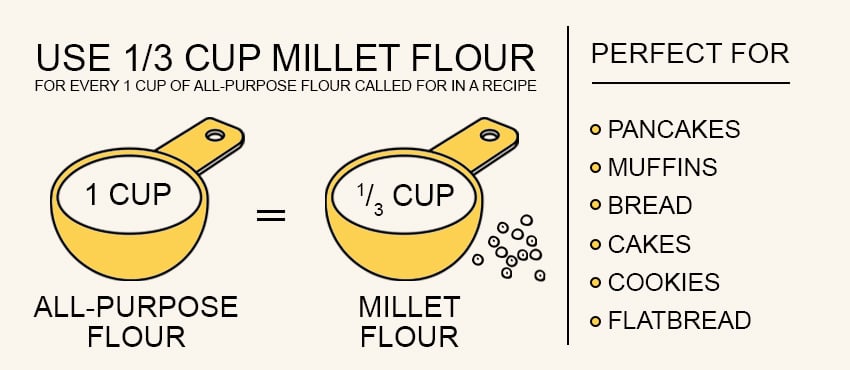
- Recipe ideas: Mini Pancake Cereal with Millet Flour
Nut Flour
Nut flour is made of crushed ground nuts. This flour can be produced from almonds, cashews, and other tree nuts. It is extremely useful because it contains proteins, vitamins (a good content of Vitamin E), minerals, and fatty acids; it improves heart, liver, and kidney functioning, strengthens the immune system. Nut flours have a unique nutty flavor.
- Perfect for: pancakes, scones, pasta, biscuits, gluten-free cookies, macarons
- Not suitable for: Not recommended for nut-intolerant people
- Protein content (1 cup): Almond flour – 24g, Cashew flour – 13g
- Substitute for all-purpose flour: Cashew flour is an absolute substitute for all-purpose flour. You can bake bread cookies, cakes, pancakes, and a lot more. It works well both with sweet and savory recipes. Almond flour, in turn, is a little moist by its nature, therefore, you should mix it with a denser flour like coconut flour to keep the desired shape of your baked goods.
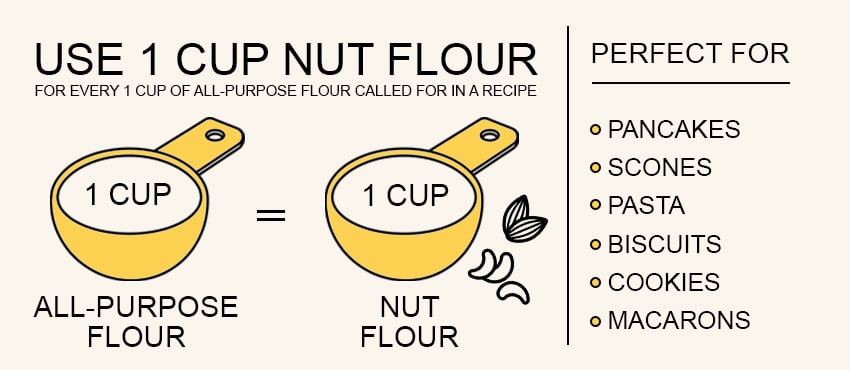
- Recipe ideas: Almond Flour Blueberry Muffins, Rosemary Cashew Flour Biscuits, Soft & Chewy Amaretti Cookies
Sponsored by Food to live
Oat Flour
Oat flour is made from ground oats. It is a very nutritious product. All because it contains soluble and insoluble fiber. The first reduces sugar levels, and the second normalizes the intestinal microflora and removes toxins. However, being gluten-free, products made from oat flour won’t have that good of a structure and moisture. For example, oatmeal cookies will crumble and the bread will turn out flat.
- Perfect for: cheesecakes, pancakes, waffles, muffins, fruit crumbles, crisps, muffins
- Not suitable for: No major restrictions
- Protein content (1 cup): 15 g
- Substitute for all-purpose flour: It’s a healthy substitute for all-purpose flour, and it’s easy to make at home. However, oat flour is not a 1 for 1 substitute for all-purpose flour. You’ll need to use oat flour recipes that are specially designed for using it. The gluten in all-purpose flour provides lift in baked goods, but oats are very dense. So if there is no recipe designed for oat flour, it’s better not to try it as a white flour substitute. Don’t expect making pizza dough or sourdough bread to taste and look good using oat flour. It won’t work! Instead, look to the oat flour recipes we’ve created. They work great with this special flour.
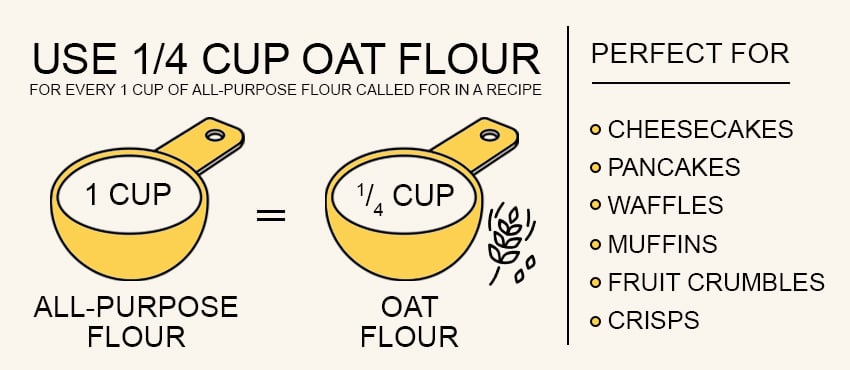
- Recipe ideas: Chai Spiced Oat & Quinoa Flour Muffins
Quinoa Flour
Quinoa flour is produced by grinding quinoa into powder. It is a valuable source of protein, fiber, iron, and unsaturated fats. Moreover, it may boost antioxidant and anti-inflammatory effects that are beneficial for the digestive system.
- Perfect for: pancakes, cupcakes, pizza, pies
- Not suitable for: No major restrictions
- Protein content (1 cup): 16 g
- Substitute for all-purpose flour: Quinoa flour can be substituted for 1/2 of the all-purpose flour in many recipes or completely replace wheat flour in cakes and cookie recipes.
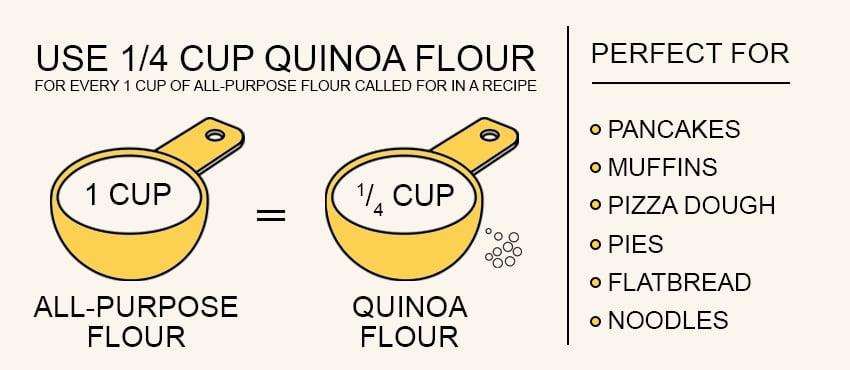
- Recipe ideas: Chai Spiced Oat&Quinoa Flour Muffins
Rice Flour
Rice flour is produced from rice grains. This flour is very popular among those keeping a healthy lifestyle. Unlike wheat flour, it is gluten-free. In addition, Rice flour is rich in protein, B vitamins, and zinc.
- Perfect for: rice noodles, pancakes, cakes, biscuits
- Not suitable for: No major restrictions
- Protein content (1 cup): 9.4 g
- Substitute for all-purpose flour: Rice flour is naturally gluten-free and its grains are much harder than wheat grains, so it doesn’t absorb liquid. You can substitute up to half the amount of all-purpose flour called for in a recipe with rice flour. Like most gluten-free flours it does a much better job if paired with other gluten-free flours to give a more rounded bake.
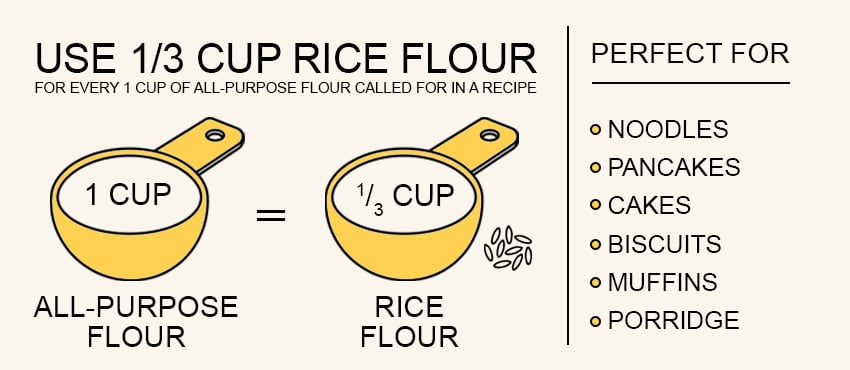
- Recipe ideas: Homemade Rice Noodles
Spelt Flour
Spelt flour is made by the stone-grinding method. Organic stone-ground spelt flour retains maximum nutrients because its processing is minimal. Therefore, by adding it to baked goods, you not only enhance the taste but also infuse them with fiber and plant proteins. It is also rich in such valuable minerals as zinc and iron.
- Perfect for: cakes, breads, muffins, scones, chocolate chip cookies, and waffles
- Not suitable for: No major restrictions
- Protein content (1 cup): 22 g
- Substitute for all-purpose flour: Spelt can be substituted one-for-one for the whole wheat in any recipe and for up to half of the flour in a recipe using entirely all-purpose flour.
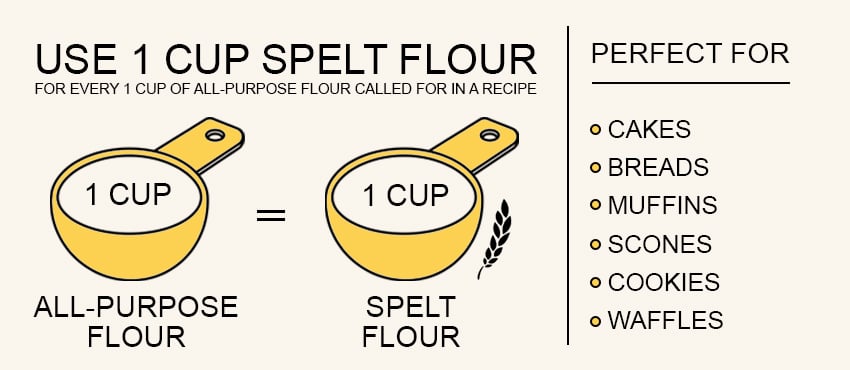
STILL IN DOUBTS WHICH FLOUR TO CHOOSE
If you are looking for the most nutritious one, buckwheat flour is definitely the best option for you. It contains the largest amount of protein with a minimum amount of fat, carbohydrates, and sugar. Oat and rice flour rank second and third accordingly since oat flour has a high content of fiber and easily digestible proteins; rice flour is good for the body as a whole – it helps strengthen bones, joints, has a positive effect on the skin, nails, and hair, and normalizes blood sugar.

Even if you don’t feel like a pro whenever you bake bread or anything else, remember the words of the famous blogger Israelmore Ayivor, who once said “Your flour is your dream and your bread is your fulfillment. The environment in which your flour is baked can influence the shape of your bread… Just take it as simple as that!”. In addition to the useful information above, we’ve created a video guide, that will serve as a great help when selecting the perfect flour for you.
TOP 10 WHEAT FLOUR ALTERNATIVES

